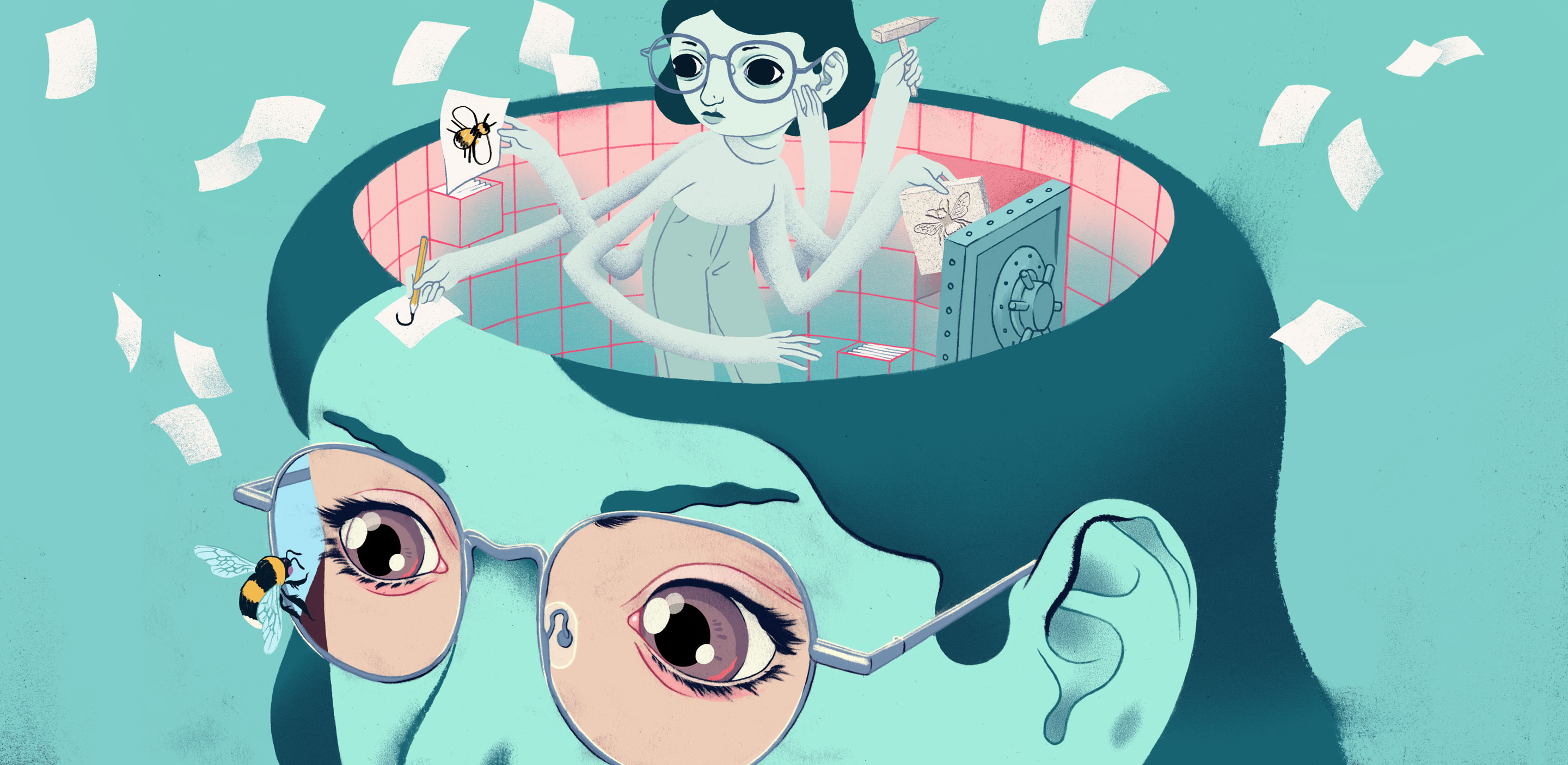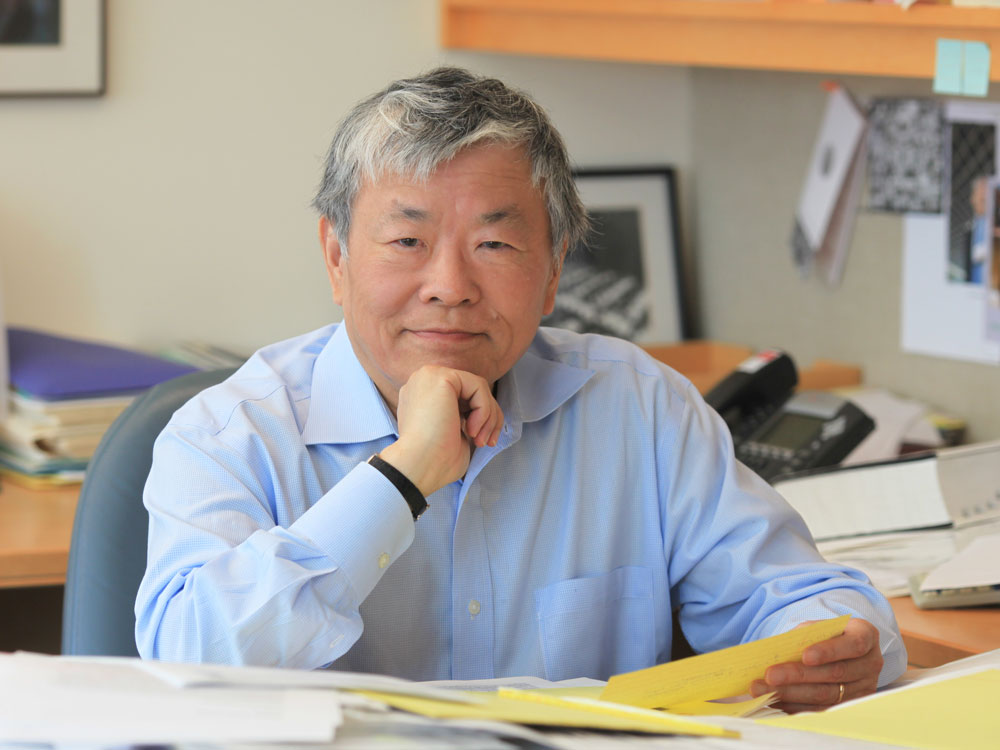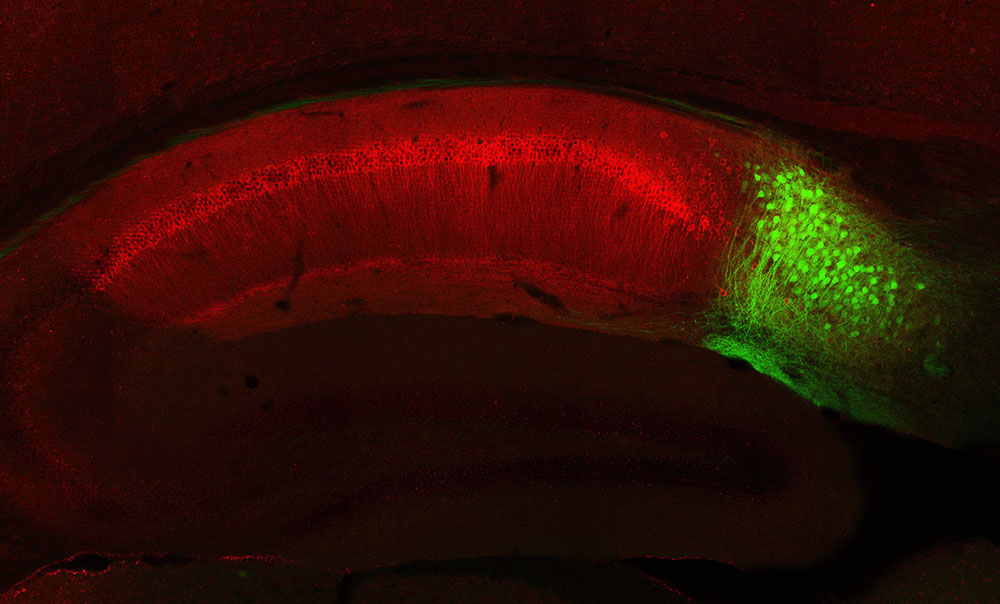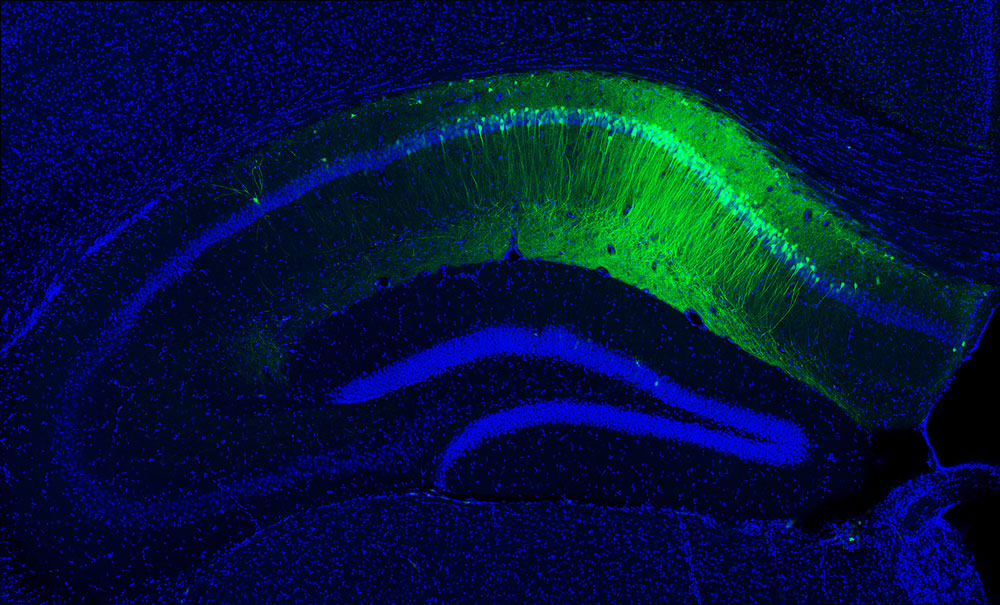Light-Triggered Genes Reveal the Hidden Workings of Memory

Neuroscientists gained several surprising insights into memory this year, including the discovery that the brain creates multiple copies of memories at once — even though it hides the long-term copy from our awareness at first.
Eero Lampinen for Quanta Magazine
Introduction
Susumu Tonegawa’s presence announces itself as soon as you walk through the door of the Massachusetts Institute of Technology’s Picower Institute for Learning and Memory. A three-foot-high framed photograph of Tonegawa stands front and center in the high-ceilinged lobby, flanked by a screen playing a looping rainbow-hued clip of recent research highlights.
The man in the portrait, however, is anything but a spotlight-seeker. Most days, he’s ensconced in the impenetrable warren of labs and offices that make up Picower’s fifth floor. His hair, thick and dark in the photo, is now a subdued silver, and today, a loosely draped blue cardigan replaces the impeccable suit jacket. His accommodating, soft-spoken manner belies his reputation as a smasher of established dogma, or at least as a poker of deep and abiding holes.
Along with his MIT neuroscientist colleague Dheeraj Roy and others, Tonegawa is upending basic assumptions in brain science. Early this year, he reported that memory storage and retrieval happen on two different brain circuits, not on the same one as was long thought. His team also showed that memories of an event form at the same time in the brain’s short-term and long-term storage areas, rather than moving to long-term storage later on. Most recently (and tantalizingly), his lab demonstrated what could someday be a way to bring currently irretrievable memories back into conscious awareness.
Tonegawa, now MIT’s Picower Professor of Biology and Neuroscience, first carved out his maverick identity back in the 1980s. While at the Basel Institute for Immunology in Switzerland, he published a theory — first seen as heretical, then brilliant — that immune cells reshuffle their DNA to create millions of different antibodies from a small number of genes. His discovery won him the Nobel Prize in 1987, which explains the oversized lobby portrait. Most researchers would have stayed in the field and basked in the attention, but Tonegawa left immunology behind entirely. He spent the next couple of decades reinventing himself as a master of memory’s workings at the cellular level.
Despite his professional stature, Tonegawa is no TED-circuit regular or fount of startup concepts. Instead of selling his ideas or his persona, he prefers to let his data speak for themselves. And they do, perhaps more loudly than some of his colleagues would like. “The way he continues to disrupt and innovate is really striking,” said Sheena Josselyn, a neuroscientist at Toronto’s Hospital for Sick Children who also studies memory formation. “He tackles the tough questions. He doesn’t do something that is easy and expected.”
Tracking Memories Cell by Cell
Upon meeting Tonegawa, I sensed that he considers his fame a slightly cumbersome side effect of his vocation. The day I visited his office, he was immersed in research banter with a colleague, breaking away only reluctantly to revisit his own journey. The whole immunology sideline, he told me, was something of an accident — his real love has always been molecular biology, and immunology was a fascinating expression of that. He ended up at Basel mostly because his U.S. work permit had run out. “Immunology was a transient interest for me,” he said. “I wanted to do something new.”

After making Nobel Prize-winning contributions to immunology, Susumu Tonegawa, now a professor of biology and neuroscience at the Massachusetts Institute of Technology, focused his passion for molecular biology on the brain.
That “something” turned out to be neuroscience, which Francis Crick and other well-known biologists were touting as the wave of the future. In the late 1980s and early ’90s, researchers knew relatively little about how the cellular and molecular workings of the brain underpin its capabilities, and nothing excited Tonegawa more than mapping unexplored territory.
Tonegawa’s venture into brain science wasn’t a complete turnabout, though, because he brought some of his investigative techniques with him. He had been using transgenic (genetically modified) mice in his immunology studies, knocking out particular genes and observing the physical effects, and he used a similar approach to uncover the biological basis of learning and memory. In an early MIT study, he bred mice that did not produce a particular enzyme thought to be important in cementing long-term memories. Although the behavior of the mutant mice seemed mostly normal, further testing showed that they had deficiencies in spatial learning, confirming the enzyme’s key role in that process.
With that high-profile result, Tonegawa was off and running. About 10 years ago, he was able to take his work to a new level of precision in part by employing a technique called optogenetics. Developed by the Stanford University bioengineer Karl Deisseroth and others, the technique involves modifying the genes of lab animals so that their cells express a light-sensitive protein called channelrhodopsin, derived from green algae. Researchers can then activate these cells by shining light on them through optical fibers. Tonegawa and his colleagues use optogenetics to generate neural activity on command in specified regions of the brain.
This method has allowed Tonegawa to show that existing theories about memory formation and storage are wrong, or at least incomplete. This past summer, along with Roy and other colleagues, he reported that — contrary to neuroscience dogma — the neural circuit in the brain structure called the hippocampus that makes a particular memory is not the same circuit that recalls the memory later. Instead, retrieving a memory requires what the scientists call a “detour circuit” in the hippocampus’s subiculum, located just off the main memory-formation circuit.
To illustrate the discovery for me, Roy called up an image of a magnified brain slice in the lab. “What you’re looking at is the hippocampus section of a mouse,” he said. He gestured to a dense cloud of glowing green neurons in the upper right — the subiculum itself — and explained that his team had genetically engineered the mouse to produce channelrhodopsin only in the subiculum’s neurons. He and his team could then activate or deactivate these subiculum neurons with piped-in laser light, leaving the surrounding neurons unaffected.

Studies have shown that the hippocampus (red) is essential for creating new memories. But short-term recall of those memories depends on a “detour circuit” involving a specialized area called the subiculum (green).
Dheeraj Roy/Tonegawa Lab, MIT
Armed with this biological switch, the researchers turned the subiculum neurons on and off to see what would happen. To their surprise, they saw that mice trained to be afraid when inside a certain cage stopped showing that fear when the subiculum neurons were turned off. The mice were unable to dredge up the fearful memory, which meant that the subiculum was needed for recall. But if the researchers turned off the subiculum neurons only while teaching the fearful association, the mice later recalled the memory with ease. A separate part of the hippocampus must therefore have encoded the memory. Similarly, when the team turned the main hippocampal circuit on and off, they found that it was responsible for memory formation, but not for recall.
To explain why the brain would form and recall memories using different circuits, Roy framed it in part as a matter of expediency. “We think these parallel circuits help us quickly update memories,” he said. If the same hippocampal circuit were used for both storage and retrieval, encoding a new memory would take hundreds of milliseconds. But if one circuit adds new information while the detour circuit simultaneously calls up similar memories, it’s possible to apply past knowledge to your current situation much more quickly. “Now you can update on the order of tens of milliseconds,” Roy said.
That difference might prove crucial to creatures in danger, for whom a few hundred milliseconds could mean the difference between getting away from a predator scot-free and becoming its dinner. The parallel circuits may also help us integrate present information with older memories just as speedily: Memories of a new conversation with your friend Shannon, for instance, can be added seamlessly to your existing memories of Shannon.
Reassessing How Memories Form
In addition to revealing that different mechanisms control memory formation and recall, Tonegawa, Roy and their colleague Takashi Kitamura (who recently moved from MIT to the University of Texas Southwestern Medical Center) have shown that memory formation itself is unexpectedly complex. Their work concerned the brain changes involved in the transformation of short-term memories to long-term memories. (In mouse experiments, short-term memory refers to recollections of events from within the past few days — what is sometimes called recent memory to distinguish it from more transient neural impressions that flicker out after only minutes or hours. Long-term memory holds events that happened on the order of two weeks or more ago.)
For decades in neuroscience, the most widely accepted model posited that short-term memories form rapidly in the hippocampus and are later transferred to the prefrontal cortex near the brain’s surface for long-term storage. But Tonegawa’s team recently reported in Science that new memories form at both locations at the same time.
The road to that discovery started back in 2012, when Tonegawa’s lab came up with a way to highlight brain cells known as engram cells, which hold a unique memory. He knew that when mice take in new surroundings, certain genes activate in their brains. His team therefore linked the expression of these “experiential-learning” genes in the mice to a channelrhodopsin gene, so that the precise cells that activated during a learning event would glow. “You can demonstrate those are the cells really holding this memory,” Tonegawa said, “because if you reactivate only those neurons with laser light, the animal behaves as if recalling that memory.”

In this magnified slice of brain tissue enhanced with an optogenetic protein, the green glow shows which engram cells in the hippocampus stored a short-term memory.
Dheeraj Roy, Tonegawa Lab/MIT
In the new Science study, the team used this technique to create mice whose learning cells would respond to light. They herded each mouse into a special cage and delivered a mild electric shock to its foot, leading the mouse to form a fearful memory of the cage. A day later, they returned each mouse to the cage and illuminated its brain to activate the brain cells storing the memory.
As expected, hippocampal cells involved in short-term memory responded to the laser light. But surprisingly, a handful of cells in the prefrontal cortex responded as well. Cortical cells had formed memories of the foot shock almost right away, well ahead of the anticipated schedule.
Yet the researchers noticed that even though the cortical cells could be activated early on with laser light, they did not fire spontaneously when the mice returned to the cage where the foot shock happened. The researchers called these cortical cells “silent engrams” because they contained the memory but did not respond to a natural recall cue. Over the next couple of weeks, however, these cells seemingly matured and became integral for recalling the memory.
“The dynamic is, the hippocampal engram is active [at first] and goes down, and the prefrontal-cortex engram is silent at the beginning and slowly becomes active,” Tonegawa said. This detailed understanding of how memories are laid down and stored could inform the development of drugs that aid formation of new memories.

Lucy Ikkanda-Reading/Quanta Magazine
Some in the neuroscience community, however, think it’s prudent to be cautious in interpreting the significance of findings like these. Last year, Tonegawa’s MIT colleagues Andrii Rudenko and Li-Huei Tsai emphasized that engram science is still so new that we don’t know exactly how engram cells might work together, nor which cells contain which parts of memories. “In these early days of functional memory engram investigation,” they wrote, “we still do not have satisfactory answers to many important questions.”
Tonegawa has asserted that brains contain silent engrams that could potentially be externally activated — an idea that strikes a few neuroscientists as overblown even as it excites others, according to Josselyn. “It really forces the scientific community to either update our thinking or try experiments to challenge that,” she said.
Bringing Silent Memories to Life
Despite the uncertainty that surrounds it, the silent-engram concept offers us the fascinating prospect of gaining access to hidden memories — a prospect that Roy, in particular, continues to explore. In October, he published a paper with Tonegawa that generated a flurry of excited emails from scientists and nonscientists alike. One of the paper’s blockbuster findings was that, at least in mice, it was possible to awaken silent engrams without using a laser light or optical fibers.

Dheeraj Roy, a postdoctoral associate at MIT, has collaborated with Tonegawa on several recent studies that have overturned old ideas about how memory works.
Vicky Roy
The question the team asked themselves, Roy said, was whether they could make hidden memories permanently active with a noninvasive treatment. A cellular protein called PAK1 stimulates the growth of dendritic spines, or protrusions, that allow communication between neurons, and Roy had a hunch that this protein — when transported into brain cells — might help bring silent engrams back into direct awareness. “Can we artificially put [in] more of one gene that would make more protrusions?” he asked, excitedly noting that this approach might be simpler than optogenetics.
To test this possibility, the researchers first gave mild shocks to mice in a cage while also suppressing their ability to make the proteins that normally cement long-term memories. When these mice returned to the same cage later on, they showed no fear, indicating that they did not naturally recall the shock in response to a cue. Yet laser light could still switch on the mice’s fearful response, which meant the memory was still there in silent-engram form.
When the team injected these mice with the PAK1 gene to make them overproduce the protein, the animals froze up spontaneously when entering the dreaded cage. They were recalling the memory of the cage all on their own: The silent engram was coming to life. When PAK1 is administered, “you just wait four days, [and] they recover it with natural cues,” Roy said. In the future, he added, a therapeutic injection of PAK1 molecules that enter the brain’s memory cells could awaken people’s silent memories as well.
“So it would just be an injected protein?” I asked.
“That’s right — one molecular transporter that has one protein. People already have ways to put proteins into brain cells. I don’t think we’re that far [away] anymore.”
It’s amazing to think that all of our minds hold hundreds or thousands of silent memories that are just waiting for the right activation to re-emerge into conscious awareness. If Roy’s findings hold true in humans, the retrieval of hidden memories might someday be as easy to initiate as getting a flu shot. “What would happen if you did that to a normal person? What would come flooding back?” I asked. “What would that experience be like?”
“Very sci-fi, even for me,” Roy said. “My family says, ‘Is this all real?’ I say, ‘Yeah, I’m not lying to you!’”
A few minutes later, back in Tonegawa’s office, I posed more or less the same question to him. Reactivating silent engrams could allow people with memory issues — like Alzheimer’s sufferers, soldiers who have survived explosive blasts and concussed athletes in contact sports — to regain memories that have become inaccessible. (To be sure, these people would often need to get such treatments early, before their conditions progressed and too many brain cells died.) Roy and Tonegawa’s past research suggests that people with cognitive difficulties have many stored memories that they simply can’t recall. But what about the rest of us who just want to mine our memories, to excavate what’s buried deep within?
Tonegawa paused to consider. “It could be these silent memories could come out,” he said. “If you artificially increase the spine density, inject enzymes which promote spine formation, then the silent engram can be converted to active engram.”
When I pressed him further, though, he exuded caution. It was as if he was used to hearing people like me run away with the possibilities and wanted to tamp down my expectations. Even though his lab successfully reactivated mice’s silent engrams after a few days, that’s no guarantee that silent engrams last very long, he said. And once the cells that encode particular memories die off from old age or dementia, it might be game over, no matter what kind of proteins you inject. Tonegawa pointed to Roy, who was sitting across from him. “I won’t remember his name.”
His patience seemed to be running out. The contrarian in him, I could tell, wanted to assert that he was a student of the essential nature of things, not a pursuer of drug patents or quick cures or even the ideal of perfect recall. “I know a joke,” he said cryptically. “Not injecting protein or genes, but I keep an external brain. I hold the information in that brain.” He pointed to Roy again — the person he counts on to remember things he can’t. “The only thing I have to do is have a relationship with that person,” he explained. It’s comforting, in a way, to know that the wizard of tracing and unlocking memories also believes that no brain is an island. “It’s better,” he said, “not to memorize everything.”
This article was reprinted on Wired.com.





